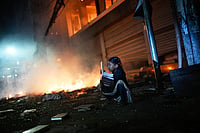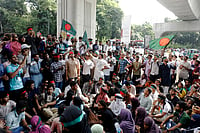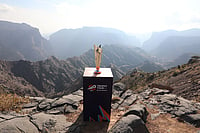Following the Taliban retreat, Afghanistan has once again been carved up into fiefdoms controlled by armed factions and military commanders. The situation is the exact replica of what it was in 1994, before the Taliban appeared to unite the bitterly divided country.
Most of the groups in power are, not surprisingly, those whom the Taliban had ousted. But for Kunduz province, where Taliban troops and foreign fighters are trapped, the Northern Alliance (NA) is now in control of almost all of northern Afghanistan. In contrast, the situation is extremely fluid in the south and east, where armed groups and former mujahideen commanders who are either opposed or even sympathetic to the Taliban have occupied a large swathe of territory. The Taliban themselves directly control only four provinces, including Kandahar where Mulla Mohammad Omar founded his puritan Islamic movement in the autumn of 1994. The neighbouring Helmand, Urozgan and Zabul provinces, which served as nurseries for Taliban recruits, are also firmly in their hands.
But the NA's control over northern Afghanistan isn't as a unified entity. Essentially a loose coalition of the Tajiks, Uzbeks, Hazaras, Turkomans and other non-Pashtoon factions, there is already a growing friction between NA components in their competitive quest to consolidate the sudden territorial gains.
The Tajik-dominated Shura-i-Nazaar controls Kabul city and the Shomali area, which includes the late commander Ahmad Shah Masood's native Panjshir valley. Masood founded the Shura-i-Nazaar to defend his Shomali domain and advance his personal ambition even though he was nominally a member of Burhanuddin Rabbani's Jamiat-e-Islami. It is on the Shura-i-Nazaar (now led by a former spymaster and Masood's chosen successor, Mohammad Faheem) that Rabbani, a Tajik from Badakhshan, is depending for staking his claims to power. Rabbani and Masood's followers also control Badakhshan and Takhar provinces bordering Tajikistan, besides boasting a military presence in northern Samangan, Baghlan, Balkh, Jauzjan, Saripul and Faryab provinces.
Yet, Rabbani can't consider these provinces his own. For, Uzbek warlord Abdul Rasheed Dostum, whose US-aided assault on Mazar-e-Sharif triggered the Taliban retreat, has always been reluctant to brook undue interference from other groups in these provinces. A former communist militia chief who switched over to the mujahideen to hasten the collapse of president Najibullah's regime in April 1992, Dostum has no qualms about entering into any unprincipled alliance to further his interest. A power struggle between him and Tajik and Turkoman commanders is only to be expected now.
Dostum's problem is that he has to also contend with rival Uzbek warlord Abdul Malik Pahlawan, who overthrew his administration after joining hands with the Taliban in 1997 in what turned out to be a brief, four-day alliance. Pahlawan later turned on the Taliban; he and the Shi'ite Hezb-e-Wahadat together massacred 4,000 Taliban in Mazar. The Taliban took their revenge the next year, capturing the town and ordering carnage.
The Hezb-e-Wahadat and other smaller Shi'ite groups like Harkat-e-Islami also pose immense problems for the mainstream NA groups. For instance, Dostum has to share Mazar's control with some Shiite leaders like Ustad Mohaqqiq. Again, Hezb-e-Wahadat boss Abdul Karim Khalili has made no secret of his plans to deploy 2,000 of his armed men in Kabul to protect the city's significant Shi'ite population and also advance his party's political agenda.The Hezb-e-Wahadat and its allied Shi'ite parties also hold the central Bamiyan province and parts of Ghour, Ghazni and Wardak provinces.
Reported Iranian backing has enabled Shi'ite fighters to increase their presence in Herat province bordering Iran, thereby forcing Tajik commander and former governor Ismail Khan to concede more powers to their groups. Yet Ismail Khan remains the dominant commander there and in Badghis and Farah provinces. A shura of tribal elders and commanders is running Farah; the neighbouring Nimruz province is under anti-Taliban Baloch and Pashtoon leaders.
In Pashtoon-dominated eastern Afghanistan, former mujahideen commander and governor Haji Abdul Qadeer has regained his office in Jalalabad, capital of Nangarhar province, and now heads a council of anti-Taliban commanders and tribal chieftains. Rival mujahideen commanders vying for the governorship have divided the neighbouring Kunarh and Laghman provinces among themselves. In southern provinces inhabited by Pashtoon tribes, Abdul Qayyum Khan and Badshah Khan have proclaimed themselves as governors of Khost province. There is still no agreement as to who would be the governor of Paktia and Paktika. The US-led attack has indeed only sharpened ethnic divisions.
Swathe Realities
After Kabul, local warlords stake their claims to key areas

Swathe Realities
Swathe Realities
Published At:
MOST POPULAR
WATCH
MORE FROM THE AUTHOR
×




















